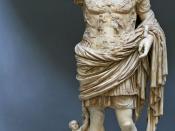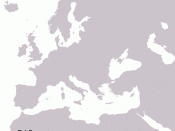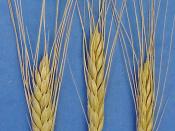Italy is blessed above all the other countries of central Europe with the natural conditions that go to yield an abundant and varied supply of food. The soil is rich...the rainfall is abundant, and rivers and smaller streams are numerous" (Johnston 203). In the ancient Roman world, A wide variety of fruits and vegetables were grown both in the rural setting and also in city gardens. According to Florence Dupont, gardens "were productive all year round and were tended by hand, manured and carefully protected from cold winds or the scorching sun." She goes on to say that "gardens were used to grow the staple vegetables of the Roman diet: brassicas, greens, marrows, sorrel, cucumbers, lettuces, leeks." A different part of the garden would "be given over to...plants that add savour to food and appease hunger: garlic, onions, cress, chicory" (Dupont 99-100). Broad beans and cabbage were also grown extensively.
Next to the vegetables so important to the Romans, the foremost crop was emmer wheat. Wheat was either baked into bread, or boiled into a type of porridge, similar to grits or cream of wheat.
Olives were another most prominent crop. The olives were eaten, but, more importantly, their oil was used extensively in cooking and for other purposes such as fuel for lamps, perfume, and body oils.
Grapes were also of extensively cultivated, providing their fruit, and, of course, the wine that nearly all Romans drank well watered down or mixed with honey at every meal. The remains or dregs of the grapes left after wine was made was used as a preservative for foods (Dupont 102).
Meat was used sparingly by the majority of Romans. During the early Republic, it had been eaten only when an animal was sacrificed to the gods. Later, meat was used...


